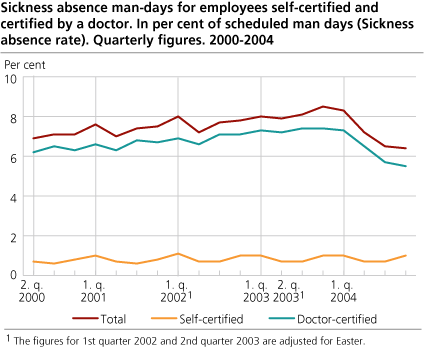Content
Published:
This is an archived release.
Strong decrease in sickness absence
The total sickness absence fell from 8.5 to 6.4 per cent from the fourth quarter of 2003 to the fourth quarter of 2004. Absence certified by a doctor fell from 7.4 to 5.5 per cent, while self-certified absence was 1.0 per cent in both quarters. The figures are taken from the central statistics on sickness absence.
The sickness absence rate for women fell by 2.4 percentage points and the sickness rate for men fell by 1.7 percentage points.
The sickness absence fell by 15 per cent form the fourth quarter of 2001 to the fourth quarter of 2004.
Decrease in all industries
The strongest decrease in sickness absence was recorded in manufacturing and construction, while financial intermediation and education had the smallest decrease.
Strongest decrease in Østfold and Finnmark
Sickness absence by place of work decreased in all counties from the fourth quarter of 2003 to the fourth quarter of 2004. Finnmark and Østfold had the strongest decrease, at 2.8 percentage points for the two types of sickness absence together. Despite the strong decrease, Finnmark still has the highest sickness absence rate at 8.0 per cent. Rogaland had the lowest sickness absence rate at 5.1 per cent. The sickness absence rate decreased the least in Oslo, by 1.5 percentage points from 7.6 to 6.2 per cent.
Decrease in all institutional sectors
The sickness absence fell in all institutional sectors. The strongest decrease was recorded in local government, from 10.0 to 7.7 per cent. The smallest decrease was recorded in central government, from 7.6 to 6.1 per cent.
Fall in long-term sickness absence
The doctor certified sickness absence fell more than the self-certified absence, and sickness absence which lasted throughout the whole quarter fell from 34.0 per cent in the fourth quarter of 2003 to 30.3 per cent in the fourth quarter of 2004.
The sickness absence rate measures man-days lost due to sickness as a proportion of contractual man-days.
Tables:
- Table 1 Sickness absence man-days for employees self-certified and certified by a doctor. In per cent of scheduled man-days (Sickness absence rate). Quarterly figures. 2000-2004
- Table 2 Sickness absence man-days for employees self-certified and certified by a doctor, by sex. In per cent of scheduled man-days (Sickness absence rate). Quarterly figures. 2000-2004
- Table 3 Sickness absence man-days for employees self-certified and certified by a doctor, by industry and type of sickness absence. In per cent of scheduled man days (Sickness absence rate). Quarterly figures. 2000-2004
Contact
-
Arbeidsmarked og lønn
E-mail: arbeidsmarked@ssb.no
-
Unn H. Høydahl
E-mail: unnh.hoydahl@ssb.no
tel.: (+47) 40 90 23 77

